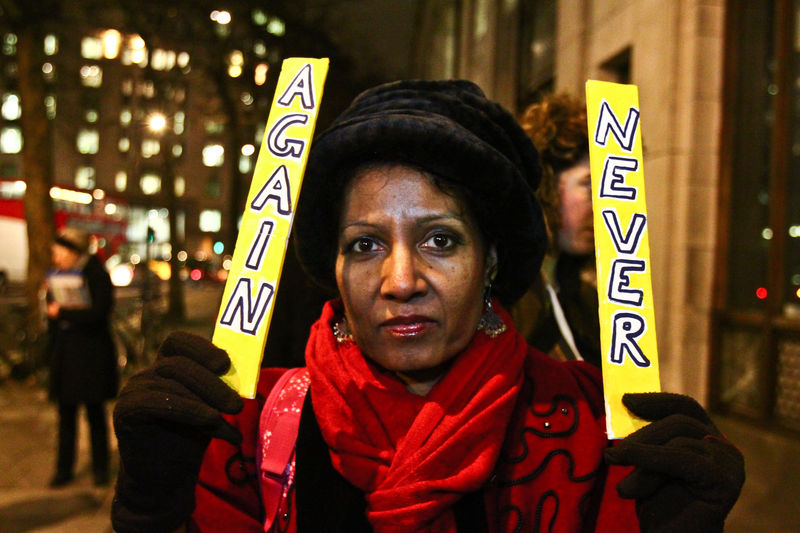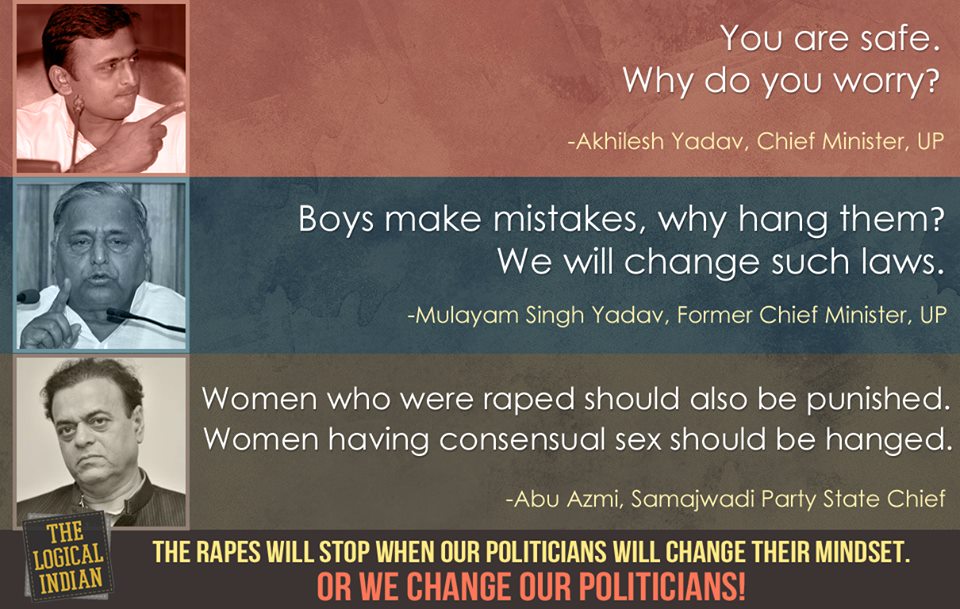
‘Never Again’ calls a protester outside India House, India's consulate in London. They are demanding justice for the gang-rape victim in Delhi. Image by Rob Pinney. Copyright Demotix (7/1/2013)
Last month, India woke up to graphic images of the lifeless bodies of two of her teenage girls hanging from a mango tree. These shocking and tragic images were widely shared across the world, but should they have been?
Two girls of the Dalit community, 14 and 15 years of age, were brutally raped and hanged from a mango tree in India's northern state of Uttar Pradesh. The incident occurred on the night of 27 May, 2014 when the two girls, who were cousins, went to a nearby field to relieve themselves, because they did not have a toilet at home. The lack of toilets is an issue in rural India ignored by many. The girls were allegedly abducted by some men of higher caste from the village Katra Sadatganj, Badaun, where the rape took place.
The local politicians and media were quick to exploit the situation.
The rape story went viral in social media in India, where several users shared the graphic images of the girls hanging from the tree by their necks. The disturbing images of the hanging shook citizens all across the country and was soon followed by public protests, both offline and online, against the recurring incidents of rape in India.
The girls’ family alleged that the two teenagers were raped and tortured before finally being hanged from a mango tree in a nearby orchard. Incensed by alleged police inaction, the families refused to take down the bodies from the tree for several hours. Finally the local police registered a case of rape only after several members of the girls’ community protested in front of the police station.
Sharing graphic images on social media
A local newspaper first published an article about the gang rape, torture and lynching of two minor girls including a graphic image which is a violation of the law. Social media picked up the picture and it was shared widely and soon went viral.
Many Indians found the images disturbing and cautioned against sharing them. Others pointed out that sharing such images were against the law.
Seriously, the Badaun images are very disturbing. Kindly think before RTing. We are all aware of the heinousness of the crime.
— Shivani Sahay (@Savitri4Ever) May 29, 2014
#Badaun #Khairlanji the depiction of images of rape victims is a criminal offense according to section 228, 376A IPC @kuffir @_pharhana
— Fightforjustice (@Neiltiss) May 30, 2014
Others saw the indiscriminate sharing, not only as a form of voyeurism and disrespect but also as objectification and exploitation of women, a “pornography of rape”, extended even after death.
Badaun. Alarmed at these images of the teenage girls splashed everywhere. Hideous voyeurism.
— Noopur Tiwari (@NoopurTiwari) May 29, 2014
Getting disturbed by images on the internet does zilch. This is one more way to objectify women, even in death. #Badaun
— Farzana Versey (@farzana_versey) May 29, 2014
After the first gut reactions, came the analysis. In her article at News Laundry, journalist Noopur Tiwari questioned what purpose is served by the sharing of these images – is it merely to sensationalize and incite mob violence? She asked:
The news media uses such images to “sell” its stories and garners instant pity or outrage. But does this really translate into concerted action leading to justice? Or is there a risk that this will simply incite crowds into asking for the lynching of the accused?
The image depicts a cruel reality with full force. Perpetrators of sexual violence often want to make a public display of their victims’ corpses to strike terror in the community they are trying to intimidate. It’s humiliation, revenge or even the marking of their “victory”. This is degrading for those who have suffered the loss. In viewing the spectacle, aren’t we, to some extent, participating in this humiliation?
Critics have condemned the circulation of graphic pictures of the two girls hanging, but many see the point why they may be effective. In her News Laundry post, Noopur Tiwari added:
The rape and killing of these teenagers would otherwise not have been registered as “truth” in public knowledge since the police were hostile. Is the circulation of such images the only way out then, for those who feel they’ve been abandoned by the state and local authorities?
In his article on First Post, Sandip Roy wrote that shocking content is often the only way to shake people out of their ennui :
We are so inured, so numbed by the never ending horror story of rape that it seems we need to descend ever lower into the pits to be shocked to attention. It’s as if faced with a rape story, the media has to ask the question “What’s new about this one?
However, in the same article he reflected that images such as these should not be the stick to beat a a nation's conscience awake. He wrote:
The gang rape of the young woman in that bus in Delhi touched a national chord and spurred the government into action into passing a stricter anti-rape law. That did not require us to see her brutalized body. If indeed we now need to see the “strange fruit” on our mango trees to be shocked, it begs the question about what kind of people we have become anyway.
Uttar Pradesh chief minister Akhilesh Yadav's comment on this incident incited further outrage in Social media.
In NirUttar Pradesh,on rapes Akhilesh Y: You are safe,aren't you? #MullahMulayam: लड़के हैं, गलती हो जाती है। #Badaun pic.twitter.com/r9FEtROqoB
— Mriganka T (@mriganka_t) May 30, 2014
The logical Indian summarized the reactions of the state's leading politicians in a Facebook post:
Some netizens noted the timid reactions from the civil society and the lack of focus by media on this news. Interestingly, the view was shared by some leading journalists too.
We won't hold candle night vigils & street protests for #Badaun and #Bhagana will we ? Speak, shout, rant. For once OUTRAGE in short supply
— barkha dutt (@BDUTT) May 30, 2014
How grotesque should a rape outside the municipal limits of Delhi be for it to qualify as headline ? #Badaun
— Siddharth Mazumdar (@mazumdar_sid) May 30, 2014
A candle lit vigil to protest against the gang rape of two teenage girls was held on Saturday, May 31, 2014 in New Delhi, India.
What comes next?
All the five accused and the two policemen who allegedly failed to file a report despite repeated requests from the girls’ family have been arrested. The recently elected Union Minister for Women and Child Welfare, Maneka Gandhi, has said that a rape crisis cell will be constituted to deal with such cases on a speedy basis.
y cant we stop it from happening.To me,arrest of accused after an innocent has been tortured & killed means nothing #stoptheshame #Badaun
— Richa Chaturvedi (@Wrricha) May 30, 2014








8 comments
Haven read this story what I feel like is that the images going viral is totally unacceptable. Yet it also became a way to share the news,as now social media activism is so common,and is very good. It was the news on social which spread the news internationally. This case given alot hype is probably due to the recent electoral process. As the new government wad elected so it was another way to pressurise the them.
Seems like the fuss is about the publication of the images, rather than the crime itself. If the government can’t exact justice, the family should.
The photos, must be shared. Yes, some will them for ill purpose. Most however, will see them for what they are, a call to action, a call to change, a call to hold people accountable.
Yes, the images are difficult, they are grisly, but silence on this issue, is no longer an option. It’s gone on far to long. Women must not be treated as mere objects, to be used and harmed and then discarded. They are human beings, equal human beings. Their lives have value and meaning and should be treated with respect.
The images MUST be shown, because evil must be dragged into the light kicking and screaming for people to not ignore it. People must not be allowed by choice, to remain “blind” to the problem.
Here too, we must raise our men to know that rape, is NEVER acceptable. Not ever!
We must not remain silent, we can not allow ourselves to be silenced. We must report injustice and evil at every turn.